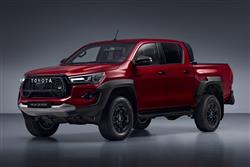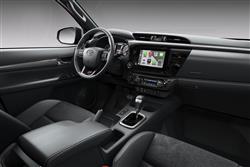Toyota Hilux - ABC Leasing
How will you view?
This is a sample, showing 30 seconds of each section.
MORE SMARTLY UNBREAKABLE(some text hidden)
By Jonathan Crouch
Ten Second Review word count: 54
Toyota's Hilux pick-up has always been unbreakable, capable and sensible. But aspirational? Possibly not. This current version of the eighth generation model might be though. It looks purposeful, there's upgraded power if you want it and the cabin looks a lot smarter than it used to. But throughout, all the old toughness still remains.
Background word count: 236
Think of a pick-up and it's quite likely that you'll be picturing a Toyota Hilux. This model has, after all, been a dominant presence in the global pick-up market for around half a century. Around 18 million examples of this truck have been produced in that time and most of them are still pounding the roads and unmade tracks of the 172 countries across the world where this model is sold. This eighth generation 'AN 120'/'AN130' version was first launched in 2016, but was substantially upgraded four years later to create the model we're going to look at here. In its lifetime, this model line has faced and overcome many significant challenges. This is, after all, the vehicle Jeremy Clarkson and Top Gear drowned, threw from the top of a tower block and still drove home. It was the first vehicle to be driven to both North and South Poles. It's conquered the Antarctic, the slopes of live volcanoes and the gruelling Paris-Dakar rally. It is, in short, for everyone from suburban builders to Libyan freedom fighters, a pick-up trusted the world over to get the job done, which is why it's still Europe's best selling model in this segment. Now though, it's a good deal smarter, though Toyota insists that none of the Hilux's essential toughness has been compromised. Still, you might now value this pick-up too much to subject it to the worst excesses.
Driving Experience word count: 398
From the original the launch of this MK8 model, the key change was the introduction of Toyota's 2.4-litre D-4D Global Diesel (GD) engine - and that still remains the line-up's core powerplant. Rather surprisingly, from the introduction of this model, the Japanese maker chose not to give our market the gutsier 2.8-litre diesel it offered to Hilux buyers in our countries - but we get it now. The 2.8 offers 204hp and 500Nm of torque and can accelerate to 62mph in 10 seconds - up to 3.2 seconds faster than the 150hp 2.4-litre unit. The more powerful 2.8-litre engine is aimed at customers who require a vehicle that's appropriate for both business and personal use - and those wanting an extremely capable leisure vehicle. It's available with either six-speed manual or automatic transmission. All Hilux variants have all-wheel drive. This is a part-time 4WD system that operates in rear-driven two-wheel drive on tarmac, but you can shift on the move into the 'H4' high range 4WD setting at speeds of up to 31mph, should conditions worsen or you be about to turn onto a muddy track. For really boggy off road work, you're going to want to further consider the possibility of switching into 'L4' low range, again something that's possible on the move, but this time at much lower speeds of up to 5mph. The Hilux is designed to tackle the toughest off-road conditions, with a 29-degree approach angle, 26-degree departure angle and 293mm ground clearance (Double Cab models). It's also capable of wading to a depth of 700mm. On tarmac, you'll need to remember that the rear suspension is, like its segment rivals, still leaf-sprung. This pick-up handles secondary route tarmac undulations reasonably for LCVs of its type though, something aided by a clever 'Pitch and Bounce Control' system that automatically adjusts engine torque to suit the road surface. For those wanting a more dynamic drive, Toyota has introduced a range-topping GR Sport II model. With this performance variant, the track - the distance between the left and right-side wheels - has been increased by 140mm at the front and 155mm at the rear compared to the standard Hilux. This improves handling characteristics, including a reduced roll angle and more precise steering response. Toyota claims there is also less noise and vibration and for the GR Sport II, the suspension and brakes have also been revised.
Pictures (High res disabled)

.jpg)
.jpg)
.jpg)

Scoring
Category: Compact Car
| Performance | |
| Handling | |
| Comfort | |
| Space | |
| Styling | |
| Build | |
| Value | |
| Equipment | |
| Economy | 70% |
| Depreciation | 70% |
| Insurance | 70% |
| Total | 66% |